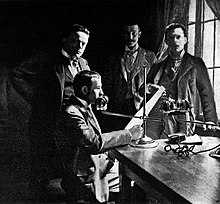Telephone newspaper
Appearance
A telephone newspaper was a telephonic distribution system of 19th and 20th centuries that offered newspaper content via telephone lines. The telephone newspapers were the earliest example of electronic broadcasting, and were superseded by the advent of radio broadcasting.
| Service | Description |
|---|---|
| Théâtrophone of Paris |  |
| Telefon Hírmondó of Budapest, |  |
| Electrophone of UK | Founded in 1895, the Elecrophone offered live theatre and music hall shows and, on Sundays, live sermons from churches. Electrophone ceased operations in 1925-26, due to competition from the radio broadcasting services. |
| l'Araldo Telefonico of Rome | L' Araldo telefonico (Italian for "The Telephone Herald") was launched in 1910, based on the Telefon Hírmondó model.[2] It was the first example of Italian broadcasting,[3] and suprpassed 1,300 subscribers in 1914[4]. The service was interrupted during the World War I. It was re-launched in 1922 under the name "Fonogiornale". In 1922, the name was changed to "Radioaraldo", and the technology was changed from telephony to radio broadcasting. The Radioaraldo opened the first radio station in the Rome. Radioaraldo collaborated with other private Italian companies to form the radio broadcasting company URI (Unione Radiofonica Italiana) in 1924; the URI became EIAR (Ente Italiano Audizioni Radiofoniche) in 1928, and finally RAI (Radio Audizioni Italiane) in 1944.[4] |
| Telephone Herald of Newark, U.S. | M. M. Gillam, a former advertising manager of the New York Herald discovered Telefon Hírmondó on a tour to Hungary, and obtained the American rights for the technology. He established the United States Telephone Herald Co. to distribute state rights. A company obtained the New Jersey rights for the newspaper started an issue at Newark in 1911. It was not successful, and ceased operations in 1912.[5][6] |
See also
References
- ^ "Wanted, A Theatrophone". The Electrical Engineer: 4. 5 July, 1890. Retrieved 2007-11-21.
{{cite journal}}: Check date values in:|date=(help) - ^ "Orologio Dell'Aria, Spettacolo Elettrico: Cosiderazioni Sull'Avvento Della Radio". Retrieved 2007-11-22.
- ^ "Le Origini Della Radiodiffusione In Italia: Ines Viviani Donarelli & Maria Luisa Boncompagni". Comitato Guglielmo Marconi International. Retrieved 2007-11-22.
- ^ a b "Le Origini Della Radiodiffusione In Italia: Cronologia 1919-2000". Comitato Guglielmo Marconi International. Retrieved 2007-11-22.
- ^ Colton, Arthur F. "The Telephone Newspaper--New Experiment in America". Telephony: 391–392. Retrieved 2007-11-20.
{{cite journal}}: Unknown parameter|month=ignored (help) - ^ Marvin, Carolyn (1990). When Old Technologies Were New: Thinking About Electric Communication in the Late Nineteenth Century. Oxford University Press. ISBN 978-0195063417. OCLC 15109205.
External links
- News and Entertainment by Telephone (1876-1925), an informative collection maintained by Thomas H. White.
- Telephone newspaper - detailed article at Citizendium
